Biosynthetic Futures
What if our possessions grew at home instead of being manufactured in a factory? What if nature had a voice? What if nature started to use humans? An article by Linnea Våglund and Leo Fidjeland.
Synthetic biology is coming. The research area, that combines engineering and the natural sciences, has the goal of creating new biological functions that do not exist naturally [1]. We can now grow meat in laboratories, modify bacteria to produce materials like spider silk and cotton and alter organisms to glow in different colors. We are heading towards a future where we will probably be able to change organisms however we want, creating biological circuits, like the digital information technology we have today [2]. But this development might also be threatening to our way of life, because we could, in theory, build a deadly virus, or release something into the wild that wasn’t supposed to be there, or instigate a new age of bioterrorism. [3]
How can we approach this?
This text describes one way of tackling this complex subject; through the use of speculative design. Three projects/scenarios are discussed, the first scenario being the bachelor project of designer Linnea Våglund, created in a discussion with the Biohacker association Bionyfiken. The other two scenarios are current work in progress at the Interactive Institute Swedish ICT [4].
Speculative Design is an emerging design field, most well know through the book Speculative Everything by Anthony Dunne & Fiona Raby [5]. Speculative design aims to transcend conventional design, discussing social, political and environmental issues, by creating strong messages that opens up people's mindset and forms a breeding ground for discussion.
Current advances in synthetic biology are here extrapolated into extreme scenarios. These scenarios are not a prediction or a forecast of the future, but an imagination of a parallel world, a possible future. From this future, we extract, materialize and design speculative artifacts that directly interact with the spectators, thereby immersing them into this alternate reality.
The scenarios and artifacts are described below.
Scenario 1: Biosynthetic Possessions
 In the year 2030, on the brink of ecological collapse, when overconsumption threatened the human existence, factories were hastily shut down to give some breathing room to the planet.
In the year 2030, on the brink of ecological collapse, when overconsumption threatened the human existence, factories were hastily shut down to give some breathing room to the planet.
The reconcile our lifestyle with the ecosystem, only biological and digital goods were allowed on the market. This led to a global surge in research on synthetic biology, and soon, we could modify organisms to grow into any shape or function. Matching the products of the old world.
A person in need of a table can now purchase a seed at a nearby supermarket, germinate it in the living room, and see it develop into a fully grown table over the coming weeks. The table requires care and attention to live and prosper, but in return, it repairs itself and can multiply and spread. And when the person doesn’t need (or want) the table anymore, it slowly dies and returns to the earth.
The burden of ownership is alleviated, as only objects that you actively use and care for remain alive. And if they die, you can always regrow a new specimen from the same DNA.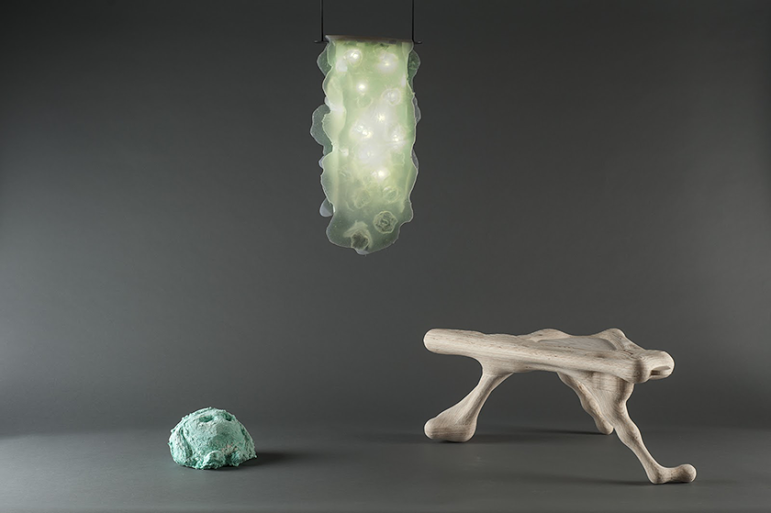 Props: The scenario is visualized with three objects, a teddy bear, a lamp, and a table. Each object asks a separate question, highlighting an aspect of the scenario and planting a thought in the spectator.
Props: The scenario is visualized with three objects, a teddy bear, a lamp, and a table. Each object asks a separate question, highlighting an aspect of the scenario and planting a thought in the spectator.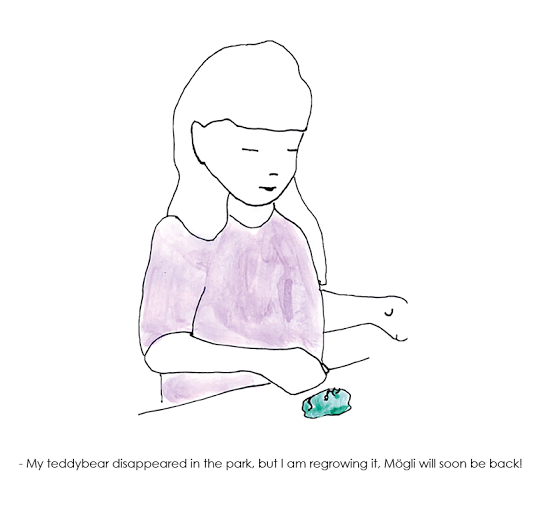 Mögli, the Teddy Bear
Mögli, the Teddy Bear
Mögli is made from modified mold that will grow with the child, getting bigger as the child gets older. What if the object closest to your child, that they treat as if it was alive, would actually be alive?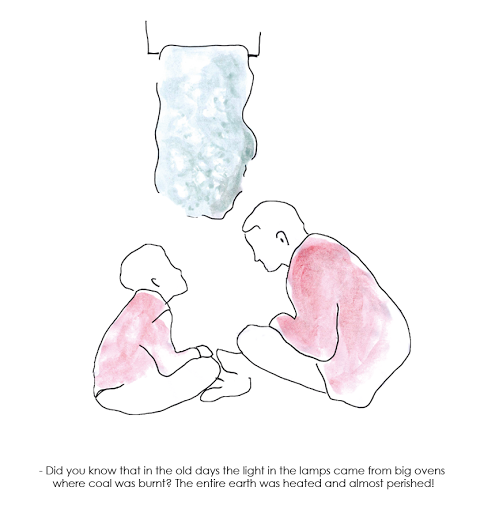 Lamp
Lamp
The lamp is made out of yeast and modified bacteria that glows without electricity. What if we don’t need electricity in the future?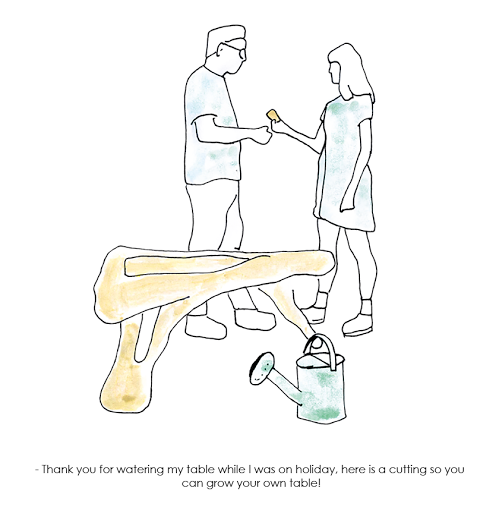 Table
Table
The table is a seed programmed to grow up to a table. The seed knows it will grow into a table right from the beginning, just like a normal seed knows it will grow into a tree. What if our things were like digital photos, that you could share with your friends, access and create from everywhere all the time?
Scenario 2: Audible Flora
 A group of DIY biohackers feel troubled by the worsening environmental condition in their city. Pollution from factories and cars are seen everywhere. As a tool for finding and elevating the problem to their fellow urban citizens, they design a new “sensor plant” that detects pollution levels and indicates the result in sound. When the plants are put in a beneficial surrounding, they “sing” beautifully. When put in a heavily polluted place, they “scream” a disturbing noise.
A group of DIY biohackers feel troubled by the worsening environmental condition in their city. Pollution from factories and cars are seen everywhere. As a tool for finding and elevating the problem to their fellow urban citizens, they design a new “sensor plant” that detects pollution levels and indicates the result in sound. When the plants are put in a beneficial surrounding, they “sing” beautifully. When put in a heavily polluted place, they “scream” a disturbing noise.
The biohackers spread their creation into the wild urban environment, and after a few years, they have spread all over town. Initially, the plants behave somewhat as expected, government and people respond to the emotional cues and the environment improves in some areas. The plants eventually mutate and are spread without control, rendering polluted areas uninhabitable. Having found a new niche in which to prosper, the sound of the plants gets stronger and stronger. It’s as if nature suddenly has a power to express itself, claiming rights to exist.
Props To immerse people in this scenario, interactive props will be designed to be displayed in exhibitions. The circuitry in these prototypes will be digital instead of biological, but it could be biological in the future.
To immerse people in this scenario, interactive props will be designed to be displayed in exhibitions. The circuitry in these prototypes will be digital instead of biological, but it could be biological in the future.
The plants will be equipped with several sensors that analyse their environment and the interaction with humans: ambient light, passive infrared, and gas sensors. The project is collaborating with artist and composer Jonas Thunberg.
Scenario 3: Human Beeings
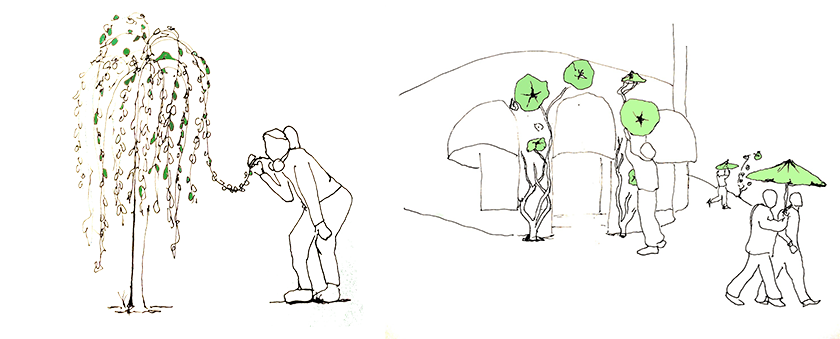 Bees are an important part of the ecosystem. Going from one flower to the next, they help a huge number of plants to pollinate and spread in return for nectar.
Bees are an important part of the ecosystem. Going from one flower to the next, they help a huge number of plants to pollinate and spread in return for nectar.
But the bees are dying. Multiple factors are causing their death: Agricultural monocultures, use of pesticides, less use of cover flowers and a blood sucking parasite called “Varroa” are some of the reasons. Their death would directly affect more than 30% of crops that we eat, but there is also a risk of ecosystemic collapse. No one really knows what we would do without them.
Meanwhile, humans are spreading, and the demand for food is constantly increasing. We seem unwilling to modify our way of life to ensure the survival of the bees.
In the lack of bees, new plants evolve that tap into human desires and needs, and start using us as pollinators.
Along jogging tracks in the south of Stockholm, the willow trees have started producing nectar that the passing joggers sip on to replenish their strength. Some of the pollen sticks in the joggers shirt, and as they drink from the next tree, the vital cross breeding occurs.
Outside a convenience store, a mysterious umbrella like plant has started appearing. When surprised by the rain, city dwellers break a branch to protect them from the rain. As they carry the branch across town, they help spread the spores of the plant.
Nobody really knows if the plants appeared by random mutation, if they escaped from a laboratory, or if they were given a “helping hand” by local biohackers.
Props
As this is a current work in progress, the next step will be to develop plant prototypes that let exhibition visitors drink nectar, pollinating and spreading the plants across the exhibition space.
These speculative scenarios do not provide answers, but asks questions to the spectators to react, reflect about and discuss:
What are the risks and possibilities of synthetic biology?
Who has the right to design nature?
How could our relation to nature change?
What might be the consequences of an escaped mutant species?
And how do we want our present and future to be like?
Scenario 1: Biosynthetic possessions started as a reaction to the fact that we own a lot of things that we seldom use. It is a comment on overconsumption and individualism. It imagines a different way of relating to our possessions.
From this project, a discussion on the relation between humanity and nature was born.
There exists a dualism in this relation, which causes nature to be seen as something radically different than humans. Such differences relate to nature not having the perceived attributes that are required for human attention, such as intelligence, power and the ability to communicate. These perceived differences cause nature to be left out of the sphere of human moral consideration.
Synthetic Biology will affect this relation, and as with many technological developments, it can have both negative and positive consequences.
People have a tendency to focus on the really disastrous or the really cool aspects of biotechnology, something synthetic biologist Drew Endy calls “the half pipe of doom” [6]. In this situation, we find it extra important to visualize scenarios that lie somewhere in between. Tangible projects that are neither dystopian or utopian, but complex enough for people to form their own moral judgement.
It can be difficult to imagine something different than the present. Technological development has the capability to disrupt this status quo, but even with new possibilities, we often incorporate the same values and ideas that we currently have, into the new products, objects or worlds that we create. Like in the science fiction series Science Fiction Theatre [7] from 1955, where there are robots, time travel, telepathy and flying saucers but still housewifes in every home.
The job of speculative design here is to show that things could infact be very different. To make people believe that change is possible, and that we have a chance to alter and improve our values, norms, societies and lives.
The advances in synthetic biology are arriving faster than we can figure out what to do with them. These advances have the power to dramatically change life as we know it. We find it very important that the discussion on what to do with this new power is in the hands of citizens, and not just scientists and experts with knowledge in the field. As designers, we can be a catalyst to such a discussion by conceptualising, materializing and visualizing possible futures. A materialization believable enough to bring about the same discussion as if the scenarios were real.
Related Work
These scenarios discuss only a small part of the ethics and implications of synthetic biology. Other design projects with different perspectives include:
Designing for the sixth extinction, by Alexandra Daisy Ginsberg, where fictional organisms are designed to clean and sustain nature, asking “can we preserve by looking forward?” [8].
Plant Fiction, by the design collective Troika, consists of 5 fictional plant species that discusses different sustainability issues, such as pollution, energy, recycling [9].
Rayfish footwear, by Next Nature, “a fictional company that offers personalized sneakers crafted from genetically modified stingray leather. It’s launch catalyzed a debate on new biotechnologies and questioned our (often all too consumptive) relationship with animals.” [10]
Victimless Leather is a semi-living growing leather jacket from human and mouse cells. It is intended to confront people with the moral implications of wearing parts of dead animals for protective and aesthetic reasons and confronts notions of relationships with manipulated living systems. [11]
About the Authors
Linnea Våglund is a designer with a BFA. in Industrial Design from Konstfack, Stockholm, who is focusing on speculative design, technology and synthetic biology. Currently, Linnea is exploring biosynthetic futures at Interactive Institute Swedish ICT. Her work has been selected for several exhibitions, and she holds talks and workshops at universities and museums. She is also a member of the 2016 Stockholm iGEM team.
Leo Fidjeland is a technologist, engineer and creative coder, with a background in Engineering Physics. He has co-founded and developed a company producing sensory instruments for sport skydivers. He is also working part time at the Interactive Institute Swedish ICT, at the intersection of design, art and technology. He is also a member of the 2016 Stockholm iGEM team.
References
Wikipedia (Retrieved May 18th, 2016), Translated from Swedish, https://sv.wikipedia.org/wiki/Syntetisk_biologi
Wikipedia (Retrieved May 18th, 2016), https://en.wikipedia.org/wiki/Synthetic_biological_circuit
Grist (2015) Synthetic Biology Explained, Video, https://www.youtube.com/watch?v=mlOFE9-3CN0
Interactive Institute Swedish ICT, (2016) Biosynthetic Sustainable Design, https://www.tii.se/projects/biosynthetic-sustainable-design
Dunne, A. & Raby, F. (2013) Speculative Everything, The MIT Press.
Endy, D. (2014) Synthetic biology - what should we be vibrating about?, Video, https://www.youtube.com/watch?v=rf5tTe_i7aA
Ivan Tors Productions, Ziv Television Programs, (1955) Science Fiction Theater, TV-series
Daisy Ginsberg. A. (2013) Designing for the Sixth Extinction, http://www.daisyginsberg.com/work/designing-for-the-sixth-extinction
Troika. (2010) Plant Fiction, http://thisisalive.com/plant-fiction-weeping-thief/
Next Nature Network (2012), Rayfish Footware, https://www.nextnature.net/projects/rayfish-footwear/
Tissue Culture & Art (TC&A) Project, (2004), Victimless Leather, https://en.wikipedia.org/wiki/Victimless_Leather